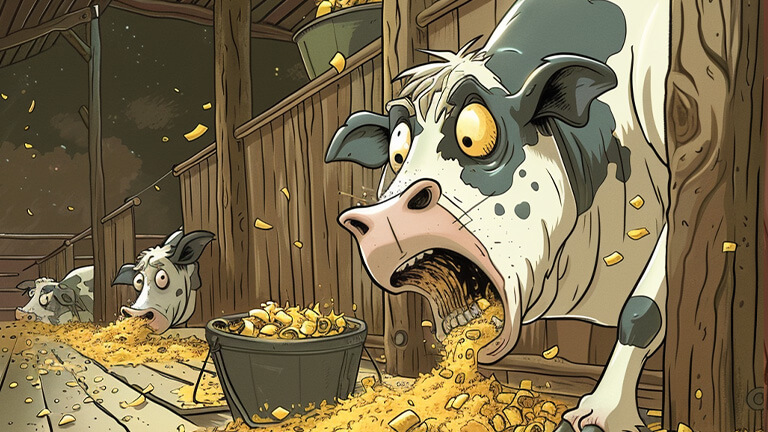Suboptimal (incomplete) diet #

If cattle receive less feed than required for an optimal diet, the diet is considered suboptimal or incomplete. This leads to the following consequences:
- The rate at which animals gain weight decreases.
- Manure production is decreasing.
- Milk production decreases.
- The period of preparation for mating increases.
- The period of pregnancy is extended.
Thus, a suboptimal diet affects the cattle basic life processes. To avoid negative consequences, it is important to provide complete, balanced feeding.
Determining the degree of these deviations from the norm with an incomplete feed ration is quite simple.
Table. The number of necessary types of feed for the optimal diet of cattle, depending on the age group
| Age, days | Types of feed |
|---|---|
| 1-60 | 7 |
| 61+ | 6 |
Calculation of weight gain, milk production and manure production with suboptimal feed rations #
Calculation of the corresponding parameters for a non-optimal diet is carried out using the formula:
For cattle aged 1-60 days:
\( N = No x A/7 \)For cattle over 60 days old:
\( N = No x A/6 \)The following variables are used in the above formula:
| Variable | Explanation |
|---|---|
| \(Nо\) | parameter value for optimal diet |
| \(A\) | number of feed types actually received |
| \(B\) | the number of feed types required for an optimal diet |
Calculation of pregnancy periods and preparation for mating of animals with non-optimal feed rations #
Calculation of the corresponding parameters for a non-optimal diet is carried out using the formula:
For cattle aged 1-60 days:
\( N = No x 7/A \)For cattle over 60 days old:
\( N = No x 6/A \)The following variables are used in the above formula:
| Variable | Explanation |
|---|---|
| \(Nо\) | parameter value for optimal diet |
| \(A\) | number of feed types actually received |
| \(B\) | the number of feed types required for an optimal diet |
Examples #
The following are examples of situations involving suboptimal cattle feeding. This will help to understand the principle of calculating production volumes, pregnancy periods and preparation for mating with an incomplete diet. The consequences of any intermediate deviations from the optimal diet are calculated in a similar way. By analyzing examples, you can figure out how the lack of one or another feed affects the cattle basic life processes. This will allow you to competently approach the organization of a balanced diet.
Situation 1 #
A young bull (age group 1-60 days) on the 60th day received only 5 types of food out of 7, and did not receive 2 types at all. We take into account that weight gain with an optimal diet on this day should have been 16 kg, and manure production should have been 28 kg.
With the specified non-optimal (incomplete) diet, weight gain will be:
X = 16 x 5/7 = ~11.42 kg.
With the specified non-optimal (incomplete) diet, manure production will be:
X = 28 x 5/7 = ~20.00 kg.
Situation 2 #
An adult cow (age group 241-420 days, initial weight 350 kg) constantly receives only 3 types of feed out of 6, and one type is received exactly half. Thus, the animal receives 3.5 types of food in total. We take into account that weight gain with an optimal diet should have been 0.275 kg, manure production - 21 kg, milk production - 5.5 liters, preparation time for mating - 6 days, pregnancy period - 26 days.
With the specified non-optimal (incomplete) diet, weight gain will be:
X = 0.275 x 3.5/6 = ~0.16 kg.
With the specified non-optimal (incomplete) diet, manure production will be:
X = 21 x 3.5/6 = ~12.25 kg.
With the specified non-optimal (incomplete) diet, milk production will be:
X = 5.5 x 3.5/6 = ~3.20 liters.
With the specified non-optimal (incomplete) diet, the period of preparation for mating will be:
X = 6 x 6/3.5 = ~10.28 days.
With the specified non-optimal (incomplete) diet, the pregnancy period will be:
X = 26 x 6/3.5 = ~44.57 days.
Situation 3 #
An adult cow (age group 61-240 days) did not receive any type of feed (she remained hungry). We take into account that weight gain with an optimal diet should have been 1.083 kg.
In the absence of all types of food, weight loss will be:
X = 1.083 x 1/3 = ~0.36 kg.
Goods (milk and manure) will not be produced. The processes of pregnancy and preparation for mating will stop on this day.